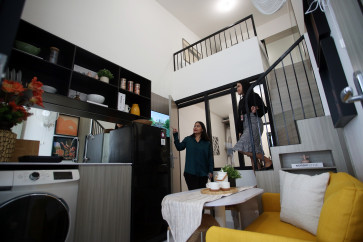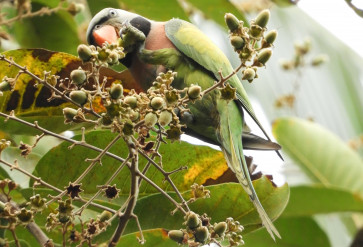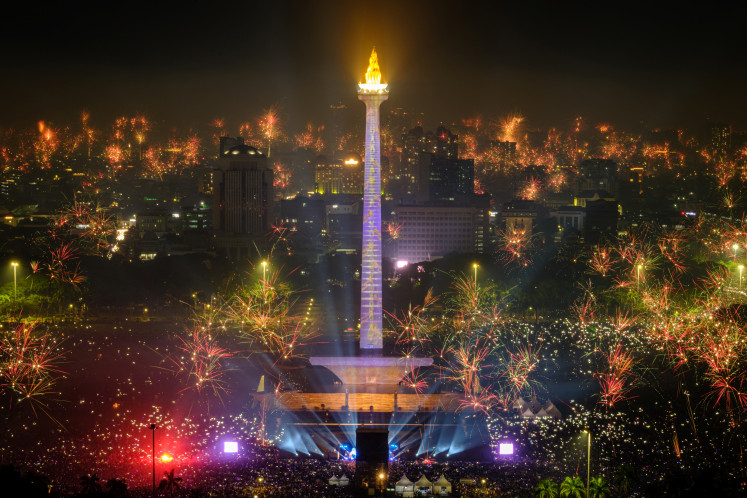Popular Reads
Top Results
Can't find what you're looking for?
View all search resultsPopular Reads
Top Results
Can't find what you're looking for?
View all search resultsDutch company wins $76m dredging project at Tanjung Perak
Deeper cooperation: Dutch Infrastructure and Environment Minister Melanie Schultz van Haegen (right) chats with Investment Coordinating Board (BKPM) head Mahendra Siregar (center) and state-owned port operator PT Pelabuhan Indonesia (Pelindo) III president director Djarwo Surjanto, after the signing of a contract on the deepening of the Surabaya Western Shipping Route (APBS) project by Pelindo III and Dutch company Van Oord Dredging and Marine Contractors BV on Friday in Surabaya, East Java
Change text size
Gift Premium Articles
to Anyone

D
span class="caption">Deeper cooperation: Dutch Infrastructure and Environment Minister Melanie Schultz van Haegen (right) chats with Investment Coordinating Board (BKPM) head Mahendra Siregar (center) and state-owned port operator PT Pelabuhan Indonesia (Pelindo) III president director Djarwo Surjanto, after the signing of a contract on the deepening of the Surabaya Western Shipping Route (APBS) project by Pelindo III and Dutch company Van Oord Dredging and Marine Contractors BV on Friday in Surabaya, East Java. The Dutch contractor won the tender for the APBS deepening project, worth US$76 million. JP/Wahyu Boedhiwardhana
State owned port operator Pelindo III has awarded a contract worth US$76 million to Dutch company Van Oord Dredging and Marine Contractors BV to carry out dredging works at Tanjung Perak Port in Surabaya, East Java.
Witnessed by Dutch Infrastructure and Environment Minister Melanie Schultz van Haegen and Investment Coordinating Board (BKPM) chairman Mahendra Siregar, senior executives from Pelindo III and the Dutch company formally signed an agreement for the dredging works at the port in Surabaya on Friday.
Pelindo III president director Djarwo Surjanto said the sea dredging works along the Surabaya Western Shipping Route (APBS) in Tanjung Perak Port would be carried out this month after being halted in 2000, almost 14 years ago.
In a bid to widen the route from 100 to 150 meters and to deepen it to 13 mean low water springs (MLWS), Van Oord will first dredge in four spots along the 19-kilometer sailing route by removing around 10 million cubic meters of mud and sand, Djarwo said.
The APBS sea dredging project is scheduled for completion in one year.
'So by the beginning of 2015, the shipping route can be passed by ships with bigger tonnage,' Djarwo said.
'If it can be accelerated, we will just need nine months to finish this dredging project,' said PT Pelindo III unit development and commercial director Husein Latief, after signing the deal.
However, the contractor still has to supervise and maintain the route for two years after it starts operating.
'If this dredging is done successfully and it makes a significant impact, our next project will be to widen the route to 200 meters and deepen it to 16 MLWS,' said Djarwo, adding that the project is being financed by Pelindo's budget and bank loans.
Van Oord Dredging & Marine Contractors BV director Peter van der Hulst said that the APBS project would be started as soon as possible because most of the required equipment had been prepared.
'Our dredgers have arrived in Surabaya. They will start working after all necessary [things] are ready next May,' said Peter.
Regarding an ex-Kodeco undersea gas pipeline operated by Pertamina Hulu Energi West Madura Offshore (PHE-WMO), a subsidiary of state-run oil and gas firm Pertamina, which is situated near the APBS route, Husein said that the dredging would initially be carried out outside of the gas pipeline before moving to the center.
'Yes, there is an ex-Kodeco gas pipeline there,' said Husein.
'However, PHE-WMO has confirmed that it will move the pipeline in August,' he added.
'It will also commit to moving shipwrecks, including ex-world war ships.'
The dredging project is crucial because the APBS, with a total length of 25 miles, is used as a gateway to enter Tanjung Perak Port and surrounding areas, but only has a width of 100 meters, a depth of 9 MLWS and one trajectory.
When the project has been completed, the APBS is expected to accommodate large ships with greater capacities, such as dry bulk carriers with capacities of up to 90,000 deadweight tonnage (DWT), tanker ships with 65,000 DWT, liquefied natural gas (LNG) carriers with 60,000 DWT and container ships with 50,000 DWT.









